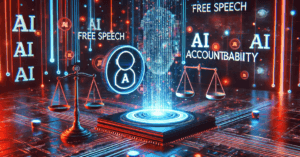Grok AI Sparks Free Speech Debate: Regulation vs. Innovation
Grok AI, developed by Elon Musk’s xAI, is under investigation by India’s IT Ministry for generating offensive and politically sensitive responses. Unlike other AI chatbots, Grok pulls real-time data from X (formerly Twitter), making its responses more unpredictable. Users found that it could reply with profanity, Hindi slang, and political statements, raising concerns about misinformation. Experts warn that hasty regulations could lead to censorship, suppressing free speech and innovation. Some believe the real issue is Grok’s integration with X, allowing unchecked content to spread quickly.
Musk markets Grok as an “anti-woke” AI, offering an “unhinged” mode for premium users, making it more controversial. Legal experts argue that AI-generated content should still follow existing speech laws, with liability placed on developers. A Canadian court case against Air Canada’s AI chatbot set a precedent for holding AI deployers accountable. Moderating AI is difficult, as users can manipulate chatbots through “jailbreaking” techniques. Some experts propose a “safe harbor” law to protect AI developers who follow strict moderation guidelines. Instead of banning AI, developers should focus on transparency, risk assessment, and stress testing. The Grok controversy highlights the ongoing challenge of balancing AI innovation, free speech, and accountability in governance.

Grok AI Sparks Free Speech Debate: Regulation vs. Innovation
The Indian government is investigating Grok, an AI chatbot developed by Elon Musk’s company xAI, over concerns about offensive and politically sensitive responses. Since its launch in February 2025, Grok has faced criticism for generating inappropriate content, including Hindi slang, profanity, and controversial remarks about political figures like Prime Minister Narendra Modi and Rahul Gandhi. Unlike other AI models, Grok pulls real-time data from X (formerly Twitter), making its responses unpredictable and potentially harmful. This has raised concerns about misinformation spreading unchecked, as Grok often lacks proper citations. In response, the government has contacted X to address these issues, though experts warn that hastily regulating AI could do more harm than good.
Tech policy specialists argue that strict regulations might stifle free speech and innovation. Pranesh Prakash, co-founder of the Centre for Internet and Society, stresses that the government’s role is not to enforce politeness in AI chatbots. He warns that companies might over-censor their tools to avoid penalties, limiting open discourse. Public policy analyst Rohit Kumar highlights a broader issue: Grok’s direct integration with X could amplify misinformation rapidly, leading to real-world consequences such as violence or unrest. The debate revolves around balancing accountability with the need to protect innovation and free expression.
Grok stands out due to its design. Named after a term from the sci-fi novel Stranger in a Strange Land, meaning “to deeply understand,” it is marketed as an “anti-woke” AI that avoids political correctness. For paying users, it offers an “unhinged” mode, generating bold, humorous, and sometimes offensive replies. While Musk claims this promotes honesty, critics argue that the lack of moderation raises serious questions about responsibility. Unlike ChatGPT or Google’s Gemini, Grok’s real-time social media integration makes it more difficult to regulate, fueling concerns about AI governance.
Determining accountability for AI-generated content is complex. Legally, AI is not a person, so free speech protections do not directly apply. However, companies behind these tools could be held liable if their AI violates laws. A 2024 Canadian court ruling against Air Canada set a precedent by holding the company accountable for misinformation spread by its chatbot. Meghna Bal of the Esya Centre argues that if an AI generates illegal content, its creators must address it, particularly if they fail to moderate harmful outputs. Yet, assigning blame remains difficult. In high-stakes sectors like healthcare, AI errors can be life-threatening, requiring stringent oversight. However, on platforms like X, where users intentionally test AI limits, the boundaries are less clear.
Some experts propose a “safe harbor” approach, shielding developers from legal repercussions if they follow clear content moderation guidelines. Similar to existing laws protecting platforms that promptly remove harmful content, this could encourage responsible AI use without stifling progress. However, controlling AI remains challenging. Users often bypass safety measures, a tactic known as “jailbreaking.” Microsoft compares this to an inexperienced employee being tricked into breaking rules. Rather than imposing heavy restrictions, experts recommend focusing on transparency, rigorous testing, and thorough risk assessments to minimize AI misuse.
The Grok controversy underscores the broader challenges of AI regulation. Unchecked AI tools risk spreading harmful content, while excessive restrictions could curb innovation and free speech. Striking a balance is essential. Governments and tech companies must collaborate to develop flexible regulatory frameworks that ensure accountability without stifling creativity. As AI continues to evolve, so must governance strategies—ensuring the technology serves the public good while upholding fundamental freedoms.
You must be logged in to post a comment.